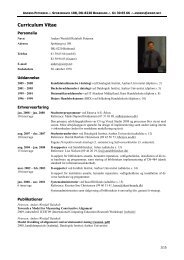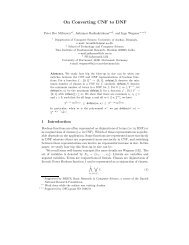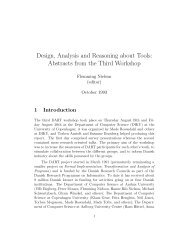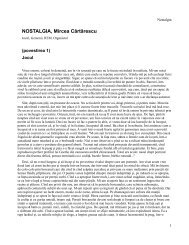towards a provotyping approach in systems development
towards a provotyping approach in systems development
towards a provotyping approach in systems development
You also want an ePaper? Increase the reach of your titles
YUMPU automatically turns print PDFs into web optimized ePapers that Google loves.
and object.<br />
In our everyday practice we usually communicate with others by focus<strong>in</strong>g<br />
on the object of conversation, not the words used: We act accord<strong>in</strong>g<br />
to the rules, norms, and values prescrib<strong>in</strong>g proper behaviour <strong>in</strong> the given<br />
community, we usually do not discuss or contemplate them. In the act of<br />
collaborative work, meta-questions concern<strong>in</strong>g participants’ roles and qualifications<br />
rarely surface. In this respect, rules, language, work-organization,<br />
and ideologies, function to a large degree as artifacts <strong>in</strong> <strong>in</strong>dividual use <strong>in</strong><br />
that they mediate between the subject and what is <strong>in</strong> focus, and thus, they<br />
become transparent and taken for granted. Moreover, it is only by virtue of<br />
this taken-for-grantedness that they function properly.<br />
To a large extent, answers to the whyquestions are taken for granted—<br />
they are ‘<strong>in</strong>visible’. In everyday life, engaged <strong>in</strong> different practices, we do not<br />
constantly ask ourselves questions about why we do the th<strong>in</strong>gs we normally<br />
do. And there are good reasons for this: we would not be able to do much<br />
else, and would probably end up <strong>in</strong> ‘existential crisis’.<br />
Bødker & Pedersen (1991), also address the question of the taken-forgrantedness<br />
of practice. They expla<strong>in</strong> the phenomenon <strong>in</strong> terms of ‘culture’<br />
or ‘<strong>systems</strong> of mean<strong>in</strong>g’ and formulate it as follows:<br />
The workplace is seen as be<strong>in</strong>g a culture. The values and beliefs of<br />
the culture are understood to have grown out of experience, and<br />
are conceptualized as a system of mean<strong>in</strong>gs underly<strong>in</strong>g artifacts,<br />
symbols, and work practices. Although referred to as a system,<br />
the culture is not explicit but implicit; that is, hidden beh<strong>in</strong>d or<br />
<strong>in</strong> the various artifacts, symbols, workrout<strong>in</strong>es, and established<br />
patterns of cooperation. (Bødker & Pedersen 1991)<br />
Edgar H. Sche<strong>in</strong> <strong>in</strong> Organizational Culture and Leadership—A Dynamic<br />
View (1985) def<strong>in</strong>es culture, his object of study, as the shared basic assumptions<br />
and convictions that are taken for granted because they repeatedly function<br />
<strong>in</strong> the everyday practice. Argyris & Schön <strong>in</strong> Organizational Learn<strong>in</strong>g:<br />
A Theoryof Action Perspective (1978) emphasize the dist<strong>in</strong>ction between<br />
the implicit assumptions that guide an organization’s actual performance,<br />
theory-<strong>in</strong>-use, and the explicit reasons, what it ‘says’ it does or is supposed<br />
to do, espoused theory.<br />
Thus, when the issue is that of utiliz<strong>in</strong>g current problems as a resource<br />
<strong>in</strong> the <strong>development</strong> of a new practice, we cannot accept these problems at<br />
12
















